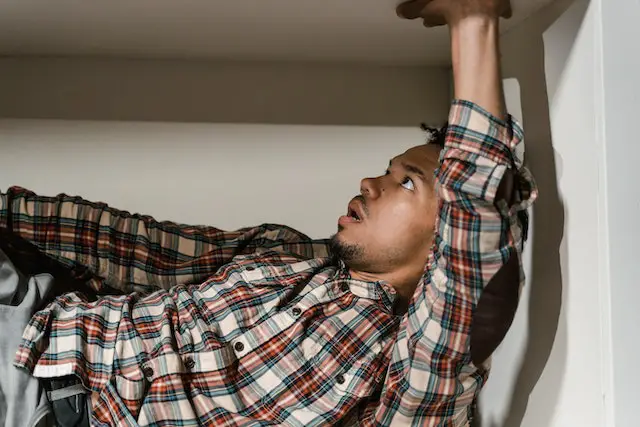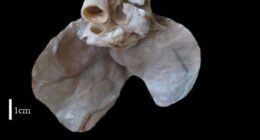Claustrophobia is a fear of confined spaces while cleithrophobia is a fear of being trapped or unable to escape. It’s important to understand the differences between these fears as they require different treatments.
Claustrophobia
(Photo By Laura Lewis on Flickr)

Claustrophobia is a type of anxiety disorder that causes an irrational fear of enclosed spaces or situations. It can be triggered by a variety of circumstances, including elevators, small rooms, tunnels, and crowds. The feeling of being trapped or confined in tight spaces often leads to intense feelings of panic and anxiety.
The exact cause of claustrophobia is unknown; however, it’s believed to be related to both biological and environmental factors. Some people may have inherited a genetic predisposition towards anxiety disorders while others develop this fear due to past traumatic experiences such as getting stuck in an elevator or being trapped in a small space.
Symptoms associated with claustrophobia include sweating, increased heart rate/palpitations, chest pain/discomfort, shortness of breath/hyperventilation and trembling/shaking. These symptoms are usually severe enough for the individual experiencing them to avoid specific situations altogether.
While there is no cure for claustrophobia per se – treatment options such as cognitive-behavioral therapy (CBT) can help individuals manage their fears more effectively over time. Through exposure therapy techniques like systematic desensitization – patients gradually confront their phobic triggers until they become less fearful over time.
Cleithrophobia
(Photo by Mario Azzi on Unsplash )

Cleithrophobia, also known as “fear of being trapped,” is a specific phobia that involves an intense, irrational fear of confined spaces. People who suffer from Cleithrophobia may experience feelings of panic and anxiety when they find themselves in situations where they feel unable to escape or move freely.
The causes of Cleithrophobia are complex and can vary from person to person. Some people may develop this phobia after experiencing a traumatic event involving confinement or feeling trapped. Others may have a genetic predisposition to anxiety disorders that can make them more susceptible to developing Cleithrophobia.
Symptoms of Cleithrophobia include sweating, shaking, rapid heartbeat, shortness of breath, and nausea. These symptoms can be so severe that they interfere with everyday life and prevent some individuals from engaging in common activities like riding elevators or airplanes.
Thankfully, there are effective treatments available for those who suffer from Cleithrophobia. Cognitive-behavioral therapy (CBT), exposure therapy, medication management and relaxation techniques such as deep breathing exercises have been found suitable for treating the condition.
If you’re struggling with the debilitating effects of Cleithrophobia – know that help is available! Consult your physician about treatment options today!
Claustrophobia Vs. Cleithrophobia – Key differences
Claustrophobia and Cleithrophobia are two closely related phobias that often get confused with each other. While both of them involve fear of confined spaces, there are significant differences between the two.
The main difference between Claustrophobia and Cleithrophobia is that Claustrophobia refers to the fear of small or enclosed spaces such as elevators, tunnels, or crowded rooms. On the other hand, Cleithrophobia involves the fear of being trapped in a confined space with no way out – like being locked in a closet or stuck in a tight space.
Another key difference is that Claustrophobic individuals may experience anxiety attacks when they feel trapped in an enclosed space. In contrast, those with Cleithrophobia tend to avoid any situation where they might become trapped.
It’s important to understand these differences when seeking treatment for either condition. A proper diagnosis by a healthcare professional can help identify which type of phobia you may be experiencing and what treatments would be most effective.
Causes of Claustrophobia
Claustrophobia is an anxiety disorder that affects millions of people worldwide. It’s characterized by a fear of enclosed or small spaces, which can lead to panic attacks and other symptoms.
The causes of Claustrophobia are not entirely understood, but experts believe that it may be caused by certain environmental factors such as childhood trauma, genetics and brain chemistry. It can also develop after experiencing a traumatic event involving confinement in small spaces like being trapped in elevators or stuck in tight spaces.
Additionally, those who suffer from claustrophobia may have had negative experiences with confined spaces in the past. For example, getting trapped inside an elevator for hours on end could cause someone to develop this phobia.
Some studies suggest that individuals who have experienced anxiety disorders or depression may be more susceptible to developing claustrophobia than others.
There isn’t one specific cause of Claustrophobia – it varies from person to person based on their individual experiences and circumstances. Nevertheless, seeking professional help can make all the difference for those struggling with this condition.
Causes of Cleithrophobia
Cleithrophobia is the fear of being trapped or confined with no means of escape. This phobia can be caused by a number of different factors, including past trauma, genetic predisposition, and learned behavior.
One common cause of Cleithrophobia is a traumatic experience in which an individual felt trapped or confined and was unable to escape. For example, if someone has been stuck in an elevator for hours without any way out before, they may develop this phobia as a result.
Another possible cause of Cleithrophobia is genetics. Some people have a higher likelihood than others to develop anxiety disorders like phobias due to their genes. If there is a family history of anxiety disorders or specific phobias such as claustrophobia or agoraphobia, then the individual may also be prone to developing Cleithrophobia.
Environmental factors can contribute to the development of Cleithrophobia. If an individual has witnessed someone else experience extreme fear or panic during confinement situations such as airplane turbulence or ride malfunctions at amusement parks then they might learn from these experiences and become scared themselves.
The causes behind Cleithrophbia are complex and varied – making it important for individuals who are struggling with this condition seek professional help from licensed therapists trained in treating anxieties and fears related conditions
Symptoms of Claustrophobia and Cleithrophobia
Claustrophobia and cleithrophobia share some common symptoms, but there are also significant differences between the two.
People with claustrophobia may feel a sense of panic or anxiety in enclosed spaces such as elevators, small rooms, or crowded places. They may experience shortness of breath, sweating, trembling or dizziness. These feelings can be overwhelming and can cause people to avoid situations that trigger their fear.
On the other hand, people with cleithrophobia specifically fear being trapped in tight spaces where they cannot move freely. This type of phobia is associated with feeling like they will suffocate if movement is restricted. They may also experience similar physical symptoms like sweating and rapid heartbeat when exposed to these situations.
Both types of phobias can significantly impact daily life by limiting activities that involve enclosed or tight spaces like traveling on planes or trains.
It’s important to note that not everyone who experiences these symptoms has a phobia. If you’re unsure whether your reactions are normal or not, it might be worthwhile speaking with a mental health professional who can help determine if treatment is necessary.
Treatment for Claustrophobia
The treatment for claustrophobia may involve different methods depending on the severity of the phobia. One common method is cognitive-behavioral therapy (CBT), which involves gradually exposing the patient to enclosed spaces in a controlled setting and teaching them coping mechanisms to manage their anxiety.
Another treatment option is desensitization therapy, where patients are exposed to progressively more confined spaces over time until they are able to handle being in small or tight spaces without experiencing panic attacks or intense fear.
In some cases, medication may also be used as a short-term solution to help alleviate symptoms of claustrophobia. Anti-anxiety medications such as benzodiazepines can provide temporary relief from anxiety and panic attacks but should only be taken under the guidance of a medical professional.
It’s important to note that seeking professional help from a licensed therapist or mental health provider is crucial when dealing with any type of phobia. They can provide personalized treatment plans and support throughout the recovery process.
Treatment for Cleithrophobia
The treatment for Cleithrophobia, like most phobias, varies from individual to individual. The first step towards treating Cleithrophobia is seeking the help of a mental health professional who can diagnose and assess the severity of the phobia. They may recommend therapy sessions or medications to manage symptoms.
Cognitive-behavioral therapy (CBT) is one effective approach in treating Cleithrophobia. CBT helps individuals identify their negative thoughts and behaviors associated with being trapped in small spaces, replacing them with more positive ones.
Exposure Therapy is another common method used by therapists in helping patients overcome their fear of being confined. This involves gradually exposing the patient to increasingly smaller spaces while teaching them coping mechanisms such as deep breathing exercises.
In some cases, medication may be prescribed to alleviate anxiety symptoms related to Cleithrophobia. Anti-anxiety medications or beta-blockers are often useful but should only be taken under medical supervision.
It’s important to remember that treatment options vary depending on each person’s needs and preferences. What works for one person may not work for another, so it’s essential always to seek professional help when dealing with any phobias or mental health issues.
Featured Image By – Photo by MART PRODUCTION








